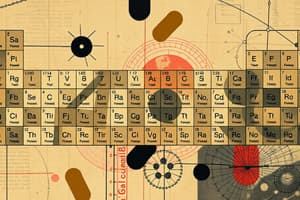Podcast
Questions and Answers
Which statement accurately describes the arrangement of elements in the periodic table?
Which statement accurately describes the arrangement of elements in the periodic table?
- Metalloids are located predominantly in the first period.
- Elements in the same group have similar chemical properties. (correct)
- All metals are located in the same horizontal row.
- Nonmetals are found on the left side of the periodic table.
How is a cation formed?
How is a cation formed?
- By gaining electrons and becoming negatively charged.
- By losing electrons and becoming positively charged. (correct)
- By undergoing a nuclear reaction.
- By fusing with another atom to gain mass.
What is the electron configuration of a sodium ion (Na$^+$)?
What is the electron configuration of a sodium ion (Na$^+$)?
- [He] 2s$^1$
- [Ne] 3s$^2$
- [Ne] 3s$^1$
- [Ne] (correct)
Which of the following reactions is classified as endothermic?
Which of the following reactions is classified as endothermic?
What is produced in a neutralization reaction between hydrochloric acid and sodium hydroxide?
What is produced in a neutralization reaction between hydrochloric acid and sodium hydroxide?
Flashcards are hidden until you start studying
Study Notes
Structure of the Periodic Table
- Organized into groups (columns) and periods (rows).
- Groups contain elements with similar chemical properties; numbered 1 to 18.
- Periods represent energy levels of electrons; numbered 1 to 7.
- Metals are located on the left side and in the center, characterized by luster, conductivity, and ductility.
- Nonmetals are found on the right side, generally poor conductors and often brittle in solid form.
- Metalloids (semi-metals) are located along the zig-zag line between metals and nonmetals, exhibiting mixed properties.
Electron Configurations
- Electron configurations describe the distribution of electrons among atomic orbitals.
- Follow the Aufbau principle, filling from lower to higher energy levels:
- Example: Oxygen (O) - 1s² 2s² 2p⁴.
- For ions, adjust configurations based on the charge; cations lose electrons, anions gain:
- Example: Na⁺ - 1s² 2s² 2p⁶ (loses one electron).
Definitions of Ions
- Ion: An atom or molecule with a net electric charge due to loss or gain of one or more electrons.
- Anion: A negatively charged ion, formed by gaining electrons (e.g., Cl⁻).
- Cation: A positively charged ion, formed by losing electrons (e.g., Na⁺).
- Monatomic Ion: An ion consisting of a single atom (e.g., Na⁺).
- Polyatomic Ion: An ion made up of two or more atoms bonded together (e.g., SO₄²⁻).
Formation of Ions
- Ions are formed through ionization, which involves the transfer of electrons between atoms.
- Metals tend to lose electrons and form cations.
- Nonmetals tend to gain electrons and form anions.
Valence of Common Ions
- Valence indicates the ability of an atom to bond based on its electron configuration.
- Common ions include:
- Na⁺: valence of +1
- Cl⁻: valence of -1
- Ca²⁺: valence of +2
- SO₄²⁻: valence of -2
Ionic Formula
- An ionic formula represents the ratio of ions in the compound.
- It is determined by balancing the total positive charge with total negative charge.
- Example: NaCl consists of Na⁺ and Cl⁻ in a 1:1 ratio.
Law of Conservation of Mass
- States that mass is neither created nor destroyed in a chemical reaction.
- The total mass of reactants equals the total mass of products.
Salt Formed in Neutralization Reactions
- A neutralization reaction between an acid and a base produces a salt and water.
- Example: From hydrochloric acid (HCl) and sodium hydroxide (NaOH), sodium chloride (NaCl) is formed.
Exothermic and Endothermic Reactions
- Exothermic Reactions: Release heat to the surroundings (e.g., combustion of methane).
- Endothermic Reactions: Absorb heat from the surroundings (e.g., photosynthesis).
Classification of Reactions
- Acid + Metal: Produces salt and hydrogen gas (e.g., HCl + Mg → MgCl₂ + H₂).
- Acid + Base: Produces salt and water (e.g., HCl + NaOH → NaCl + H₂O).
- Acid + Carbonate: Produces salt, water, and carbon dioxide (e.g., HCl + CaCO₃ → CaCl₂ + H₂O + CO₂).
- Combustion: Reaction of a substance with oxygen, producing carbon dioxide and water.
- Combination/Synthesis: Two or more substances combine to form one product (e.g., A + B → AB).
- Decomposition: A compound breaks down into simpler substances (e.g., AB → A + B).
Studying That Suits You
Use AI to generate personalized quizzes and flashcards to suit your learning preferences.




